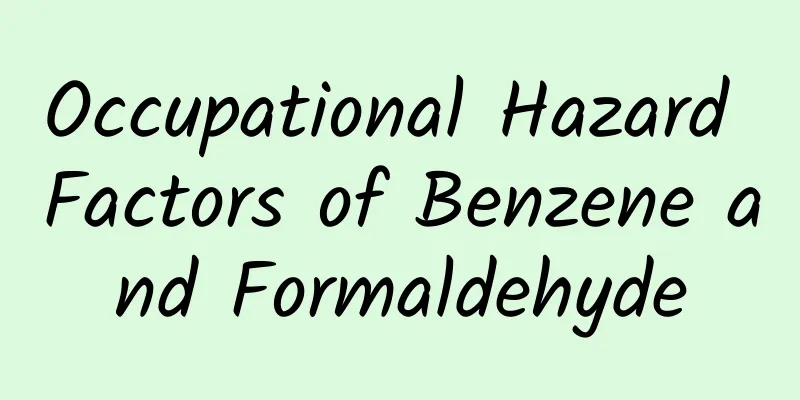Occupational Hazard Factors of Benzene and Formaldehyde

|
1. Benzene: 1. Health Hazards Due to its high volatility, benzene can easily spread when exposed to air. When humans and animals inhale or come into contact with large amounts of benzene through their skin, it can cause acute and chronic benzene poisoning. Some research reports have shown that part of the cause of benzene poisoning is the formation of phenol from benzene in the body. Special attention: (1) Long-term inhalation can damage the human nervous system. Acute poisoning can cause nerve spasms and even coma and death. (2) Among leukemia patients, a large proportion have a history of exposure to benzene and its organic products. 2. Safety measures Store in a cool and ventilated place, away from fire and heat sources. Store separately from oxidants, edible chemicals, etc. Do not use tools that are prone to sparks. 3. Fire extinguishing methods Flammability: Flammable. Fire extinguishing agent: foam, dry powder, carbon dioxide, sand. Water is ineffective. 2. Formaldehyde 1. Toxic effects The main harm of formaldehyde is the irritation to the skin and mucous membranes. When the formaldehyde concentration reaches a certain level in the room, people will feel uncomfortable. A formaldehyde concentration greater than 0.08m3 can cause red eyes, itchy eyes, throat discomfort or pain, hoarseness, sneezing, chest tightness, asthma, dermatitis, etc. The formaldehyde content in newly renovated rooms is high, which is the main cause of many diseases. LD50: 800 mg/kg (rat oral); 2700 mg/kg (rabbit dermal). LC50: 590 mg/m3 (rat inhalation). 2. Acute poisoning Excessive formaldehyde concentration can cause acute poisoning, manifested as burning pain in the throat, difficulty breathing, pulmonary edema, allergic purpura, allergic dermatitis, increased liver transaminase, jaundice, etc. 3. Chronic harm Formaldehyde poisoning Formaldehyde has a pungent odor that can be smelled at low concentrations. The human olfactory threshold for formaldehyde is usually 0.06 to 0.07 mg/m3. However, there are large individual differences, and some people can reach 2.66 mg/m3. Long-term, low-concentration exposure to formaldehyde can cause headaches, dizziness, fatigue, sensory disorders, reduced immunity, drowsiness, memory loss, or neurasthenia and depression; chronic poisoning is also extremely harmful to the respiratory system. Long-term exposure to formaldehyde can cause respiratory dysfunction and liver toxicity, manifested as liver cell damage, abnormal liver radiation energy, etc. Causes gene mutation Since 2010, it has been found that formaldehyde can cause gene mutation, chromosome damage, and octave breakage in mammalian cell nuclei. Formaldehyde has a combined effect with other polycyclic aromatic hydrocarbons, such as benzopyrene, which can enhance toxicity. Carcinogenic Animal research found that rats exposed to 15μg of formaldehyde per cubic meter for 11 months can develop nasal cancer. A new study published by the National Cancer Institute on May 12, 2009 shows that chemical factory workers who frequently come into contact with formaldehyde have a much higher chance of dying from cancers such as blood cancer and lymphoma than workers who have less exposure to formaldehyde. Researchers surveyed 25,000 chemical factory workers who produce formaldehyde and formaldehyde resins and found that workers who have the most exposure to formaldehyde have a 37% higher mortality rate than those who have the least exposure. Researchers analyzed that long-term exposure to formaldehyde increases the risk of developing special cancers such as Hodgkin's lymphoma, multiple myeloma, and myeloid leukemia. Symptoms of poisoning When the formaldehyde concentration reaches 0.06-0.07 mg/m3 per cubic meter of air, children will experience mild asthma. When the formaldehyde in indoor air reaches 0.1mg/m3, there will be odor and discomfort; When formaldehyde reaches 0.5mg/m3, it can irritate the eyes and cause tears; When formaldehyde reaches 0.6mg/m3, it can cause throat discomfort or pain. When the concentration is higher, it can cause nausea and vomiting, coughing, chest tightness, asthma and even pulmonary edema. When the formaldehyde concentration reaches 30mg/m3, it will cause death immediately. 4. Removal method (1) Ventilation method By circulating indoor air, the content of harmful substances in the indoor air can be reduced, thereby reducing the harm of such substances to the human body. In winter, people often close doors and windows, and the indoor and outdoor air cannot circulate. Not only will the formaldehyde content in the indoor air increase, but radon gas will also continue to accumulate and even reach a very high concentration. Advantages: good effect, no cost Disadvantages: long time, generally it takes more than three years to remove formaldehyde. (2) Traditional Law 300 grams of black tea soaked in two basins of water, put into the room, and open the window for ventilation, the indoor formaldehyde content will drop by more than 90% within 48 hours, and the irritating smell will be basically eliminated. Another option is to put some pineapple and other fruits indoors. Advantages: It seems that the smell is less. Disadvantages: It just uses a smell to cover up the smell of the decoration, and the harmful gas still exists in the room. (3) Plant Law Plants can be used for low-level pollution: Generally, plants can be used for indoor environmental purification when the pollution is mild. Choose and place plants according to the different functions and size of the room. Plants that can remove formaldehyde residues include: spider plant, aloe vera, cactus, peace lily, green radish, agave, tiger tail orchid, ivy, osmanthus, Brazilian dragon bone, Milan, Monstera, etc. Advantages: safe and without side effects Disadvantages: has a certain effect, but can only play an auxiliary role. (4) Plant-based purification method AQ air purifier spray is released into the air and quickly vaporizes, producing a large amount of colorless and odorless (micro-puncture factors) that puncture the molecular structure of bacteria, viruses, VOCs and odor sources in a non-toxic and pollution-free way, instantly decomposing formaldehyde into carbohydrates to purify the space and contact surfaces. First of all, compared with chemical formaldehyde removal methods, plants are safer and have no secondary pollution. Compared with chemical removal methods, because it is extracted from plants, it has better effects. |
>>: The differences between GSV factory audit, C-TPAT and anti-terrorism factory audit
Recommend
eBay's latest review policy
Because eBay is a sufficiently powerful and trust...
ICTI New Content
ICTI New Terms Section 1: General Guidelines 1.1 ...
How is Guangsuda? What services does Guangsuda provide?
How about Guangsuda? Shenzhen Guangsuda Logistics...
Sedex factory audit document list
Sedex factory audit document list 1.1 Company Ins...
How is MaBang ERP? How much does it cost? Which platforms does MaBang ERP connect to?
How about MaBang ERP? Mabang ERP is the flagship ...
What should I pay attention to when writing a reply email to a seller on Ebay? Are there any tips?
eBay is one of the largest C2C websites in the Un...
How is Qibang International? What services does Qibang International provide?
How about Qibang International? Qibang Internatio...
Benefits of Timberland factory inspection
Benefits of Timberland factory inspection (1) Est...
FSC Forest Certification Audit Process
So far, there are many FSC forest certification s...
Walmart's latest standard high-risk items in 2013: deductions and benefits
1. Collecting fees for PPE, factory uniforms, etc...
Business Report--Amazon Business Report
Business Report is a store data statistics automa...
What is Dianxiaomi? Is there any charge for using Dianxiaomi?
What is Shop Secret? Dianxiaomi is a SaaS system ...
New factory inspection requirements: woolworths factory inspection
New factory inspection requirements: woolworths fa...
Detailed version of holiday and anniversary leave policy
Order of the State Council of the People's Re...
Findmyfbid - Helps you find Facebook ID easily
This tool helps you easily find your Facebook per...









